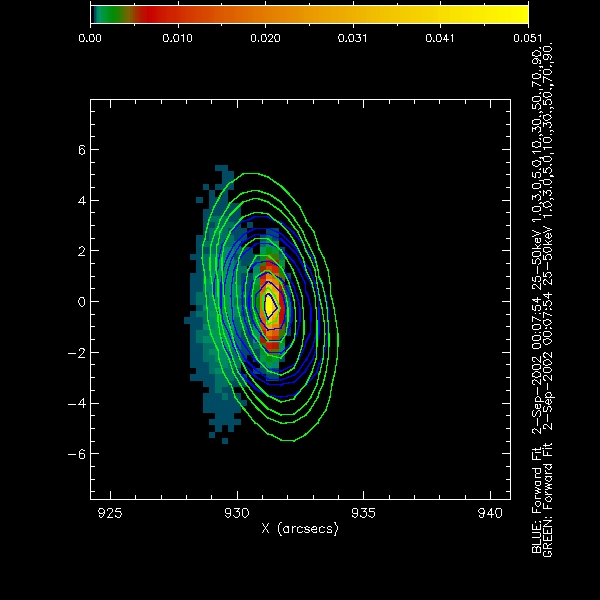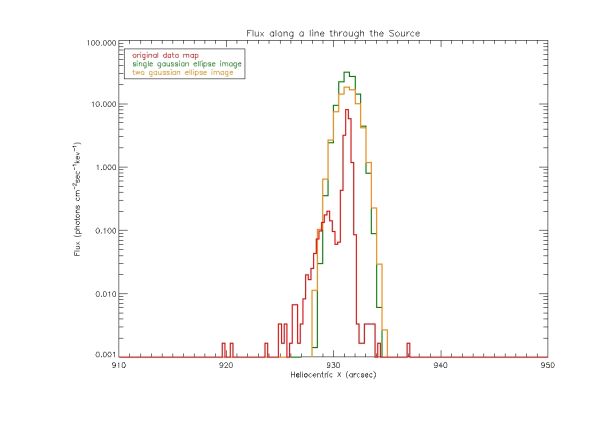Weekly Report 6Aug2010
Weekly Report 6Aug2010
10th RHESSI Workshop
Attended the 10th RHESSI Workshop in Annapolis, MD.
- Attended the discussion on Albedo, Directivity, and Polarization. Spoke to Eduard Kontar about creating additional simulations of a point source with albedo at disk center and near the limb. The purpose of these would be to check the issues of dynamic range when trying to image the diffuse extended albedo source and the bright point source. Currently for a simulated source near the limb with an albedo we have not been able to image the expected foreshortening in the albedo, however most imaging methods have done a reasonable job of imaging the compact source. Checking images made from simulations of the albedo and point source with varying ratios of flux between the two would show how large the flux of the albedo would have to be relative to the point source to successfully image the foreshortening effect. The images at disk center would provide a control to show if the extended albedo source can be successfully imaged before the foreshortening effect is observed. Currently with direct imaging methods the foreshortening effect near the limb is the best way to differentiate an extended source due to albedo from an extended source producing emission directly.
- Attended the discussion on RHESSI Imaging Techniques. I was given the task of creating images from simulated data using the Clean and Forward Fit imaging methods. The images will be created from simulated source configurations selected to mimic common source configurations from real flares. Eventlist files will be created from the simulated data to be used with the HESSI Imaging Software. I will be responsible for creating images using the default settings for both imaging methods then trying to optimize the methods by adjusting the default parameters. The images for both algorithms will be compared to the original map of the simulated data in the case of using the default parameters and optimizing the parameters. This comparison will be done using the C statistics produced by the HESSI software for each image created as well as by creating a difference map of the image and the original data. This difference will then be normalized using a root mean squares method.
The results for each algorithm (the rest of the imaging methods have been assigned to other members of the Imaging Techniques group) will be compared with the others to check which algorithms most accurately recover the original image under a given set of conditions.
- Attended the RHESSI Visibilities discussion. Spoke to Gordon Hurford about the possibility of using radio astronomy software with the RHESSI data to create images. This might be useful because there are visibility imaging algorithms contained in the software which are not available in the HESSI software, for instance the radio software contains a clean algorithm using visibilities. As per Gordon's suggestion I contacted Tim Bastion at NRAO who has previously run a test case attempting to create an image from RHESSI visibility data using the radio software. He confirmed that it was possible with the old version of the Astronomical Imaging Process System (AIPS) software but he has not done it with the new version of the software, the Common Astronomy Software Applications (CASA). I'm trying to figure out what format the RHESSI data has to be in to be usable with CASA. I will attempt to create a RHESSI image with CASA once it has been installed on hesperia.
Profile for a Single Ellipse and Two Ellipse Image using Forward Fit
Below are the contours for two reconstructed RHESSI images using the Forward Fit algorithm. The background is the original simulated data map. The blue contours show a fit using a single elliptical Gaussian. The green contours show a fit using two elliptical Gaussians.

Both images are centered around the point source on the original map. The image with a single elliptical Gaussian appears more compact than the image with two elliptical Gaussians. The image with two elliptical Gaussians may be asymmetric along its minor axis, perhaps showing evidence of foreshortening along the Heliocentric X direction.
The figure below shows the flux profile of the reconstructed Forward Fit images and the original data map along a line parallel to the Heliocentric X axis through the center of the source.
Looking at the plot above it is difficult to see any evidence of foreshortening in the heliocentric X direction toward the center of the sun. Both images correctly image the location of the point source. However the contours away from the point source for the two elliptical gaussian image are at such low flux levels that the profiles of the two curves are very close. Forward fit using two elliptical gaussians does not image the foreshortening of the albedo.
Goals for Next Week
- Compare the profiles for images created using the same imaging methods at disk center to those created near the limb for a point source with albedo to see if the images near the limb show any foreshortening relative to those at the center. I'm planning to compare them directly by translating the peak of the profiles so they match. I'm not sure this is the best approach. Any suggestions?
- Create Clean and forward fit images using the simulated sources currently available for studying the differences between imaging methods. Write IDL routines to calculate the difference maps using Root Mean Square techniques for the reconstructed images relative to the original simulated data.
- Contact the CASA software support to figure out what format RHESSI data needs to be in to be usable with their software package. Work with Joshua Malinowski on installing the CASA software package on hesperia
